AIWW Aquatech: Exhibition floor shows plenty water treatment technology for recovery
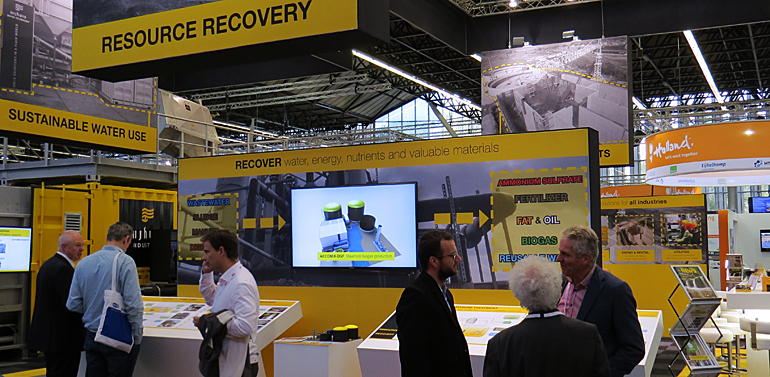 Many exhibitors at the 25th edition of Aquatech Amsterdam trade exhibition showed a water treatment technology to recover biogas or raw materials from waste water and raw drinking water.
Many exhibitors at the 25th edition of Aquatech Amsterdam trade exhibition showed a water treatment technology to recover biogas or raw materials from waste water and raw drinking water.
Not all of this technology is brandnew, such as anaerobe waste water treatment to recover biogas.
However, the trade exhibition featured many novelties for recovery of valuable materials such as calcium pallets, bioplastics, alginate and fertilizers.
Aquatech Amsterdam is part of the third Amsterdam International Water Week that was held from 1 to 6 November in the Netherlands.
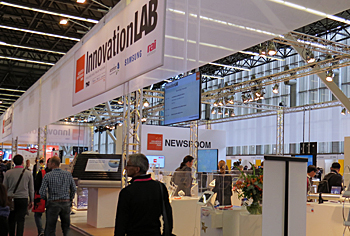 Creation of a value chain
Creation of a value chain
Many exhibitors at this year's Aquatech Amsterdam reported that their clients are seriously interested in this new treatment technology to recover valuable materials from their water streams.
So apparently clients are very aware of the possibility to lower their operational costs by selling raw materials they can recover from their water streams. However, most clients lack access to the markets where these materials can be sold.
So the talk on the trade floor was not only about the water technology itself, but also about how to create a value chain for recovered materials.
Innovation Lab: the next generation water technology
The Dutch water technology sector was well represented at Aquatech Amsterdam showing their latest products.
There was a large booth called Innovation Lab with the visible results of several incubation programmes. This booth gave a good insight of the next generation water technology, such as UV-Led technology (Wetsus), shower heat exchanger (Waternet) and cold anammox wastewater treatment (Dutch water authorities).
The renowned Dutch water technology suppliers presented their latest recovery systems that have already entered the market
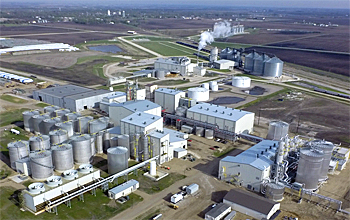 Paques' flagship is the full water treatment installation at the Poet-DSM plant in Sioux Falls, USA where the cellulose from corncobs is converted to ethanol biofuel.
Paques' flagship is the full water treatment installation at the Poet-DSM plant in Sioux Falls, USA where the cellulose from corncobs is converted to ethanol biofuel.
Recovery of energy and nutrients from wastewater
Dutch water technology supplier Paques offered its latest anaerobe waste water treatment technology for clients that seek to reduce their water and carbon footprint.
A few years ago Paques choose to focus on resource recovery as the core of its business. At the heart of Paques' wastewater treatment technology is the Biopack IC technology that can recover energy and nutrients.
"We believe it is only a matter of time till there will be a radical change and wastewater is no longer a redundant stream but rather becomes a resource for entirely new products. The created value will be many times higher", said CEO Stephan Bocken of Paques on the occasion of Aquatech Amsterdam.
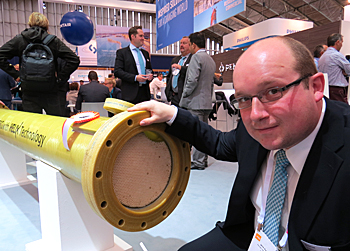 R&D manager Jens Potreck of Pentair X-Flows shows the new Helix UF membrane technology with a helical spacer to increase the flux.
R&D manager Jens Potreck of Pentair X-Flows shows the new Helix UF membrane technology with a helical spacer to increase the flux.
More clean water with higher flux
More or less the same story goes for membrane specialist X-Flow, that is part of Pentair. Many years ago the Dutch-based X-Flow introduced a new cross flow UF membrane technology to treat raw drinking water from surface water. The cross-flow technology is now also applicable for the treatment of waste water.
At Aquatech Amsterdam the company showed their latest development: the Helix tubular UF membrane technology.
The tubes of this new UF membrane are not regular but are produced with ridges that provide turbulence and enhanced feed water mixing. This prevents the formation of cake on the membranes allowing a higher permeate flow at lower crossflow velocities.
X-Flow claims that its new Helix membrane technology either - whatever the client prefers - increases the flux up to 50 percent or reduces the energy consumption up to 50 precent.
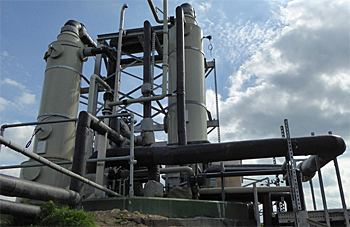 Nijhuis' first NAR-installation at poultry processing company Bernard Matthews, UK, treats 75 m3/day recovering 25-40 percent ammonium sulphate.
Nijhuis' first NAR-installation at poultry processing company Bernard Matthews, UK, treats 75 m3/day recovering 25-40 percent ammonium sulphate.
Recovery of ammonia from digestate
A novelty at Aquatech Amsterdam was the Nijhuis Ammonia Recovery system (NAR). This new system has been developed for the treatment of digestate and manure with high ammonia concentrations.
These waste streams are often dewatered, resulting in a cake fraction and rejection water.
Nijhuis' new NAR system adds a stripper and a scrubber to recover ammonium sulphate from the rejection water from drying the cake.
An additional advantage of this extra treatment step is the improved quality of the digestate that allows the production of more biogas.
Nijhuis claims that its NAR treatment removes up to 80 percent of all ammonia so the treatment of the remaining wastewater uses less chemicals.
Nijhuis developed the NAR technology in cooperation with London-based poultry processing company Bernard Matthews and Holton Renewable Energy Ltd. The NAR-installation at Bernard Matthews treats 75 m3/day recovering 25-40 percent ammonium sulphate.
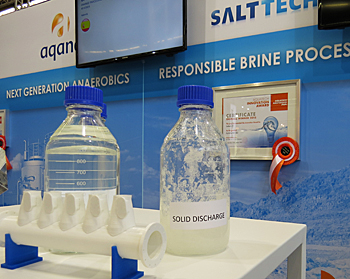 Easy-to-handle dry brine from the awarded Salttech's DyVaR desalination technology.
Easy-to-handle dry brine from the awarded Salttech's DyVaR desalination technology.
Recovery of solid dry brine from desalination
Water technology supplier Salttech won the Aquatech innovation award with its DyVaR technology to treat water with extreme high salt concentrations.
The advantage of this new technology is that the remaining brine is very dry. It is easy to handle.
This makes DyVaR more environmentally friendly compared to conventional desalination technologies that concentrate the salt in a remaining water stream that is pumped back into the sea, including the chemicals that have been used.
DyVar technology is already applied in the oil and gas industry at a location in Texas, USA.
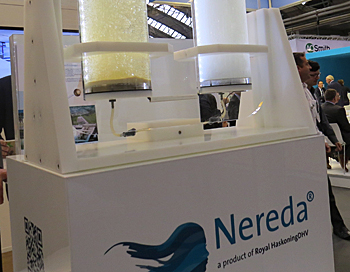 Recovery of alginate from granular sludge
Recovery of alginate from granular sludge
At their booth water technology supplier Royal HaskoningDHV showed its new Nereda technology to treat waste water more efficiently on a smaller footprint.
More or less by accident a researcher at the Delft University of Technology recently discovered that Nereda granules have a high concentration of alginate. Alginate is a substance that is used in a wide variety of applications as thickener, stabilizers and gelling agents.
Recognizing the value of alginate, Royal HaskoningDHV has already developed a recovery technology. The company is now studying the options to bring the recovered alginate to the market.
Read also on this website
● AIWW Aquatech: Young water professionals want less talking, more action, 6 November 2015
● AIWW Aquatech: Mozambique and the Netherlands agree on water supply and flood risk management projects, 5 November 2015
● AIWW Aquatech: VEI and World Resources Institute join forces on green utilities, 5 November 2015
● AIWW Aquatech: Royal HaskoningDHV and World water academy establish special academy for Nereda technology, 5 November 2015
● AIWW Aquatech 2015: Award winners Salttech and Safi Sana honoured during opening ceremony, 3 November 2015
● AIWW Aquatech 2015: Opening ceremony marks tremendous global water challenges ahea, 2 November 2015
● Buzzing city: Water professionals start to gather for Amsterdam International Water Week, 31 October 2015
● Meet the Dutch water sector at AIWW2015
More information
Amsterdam International Water Week
www.internationalwaterweek.com
Aquatech Amsterdam
www.aquatechtrade.com/amsterdam
Paques
Balk, the Netherlands
+31 514 60 85 00
www.paques.nl/en
Pentair X-Flow
Enschede, the Netherlands
+31 53 428 73 50
www.xflow.pentair.com
Salttech
Sneek, the Netherlands
+31 515 200 230
www.salttech.com
Nijhuis Industries
Doetinchem, the Netherlands
+31 314 74 90 00
www.nijhuisindustries.com
Royal HaskoningDHV
Amersfoort, the Netherlands
+ 31 88 348 20 00
www.royalhaskoningdhv.com



